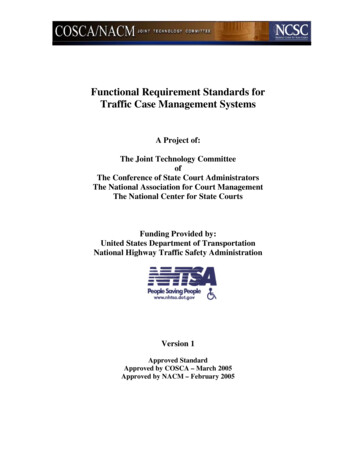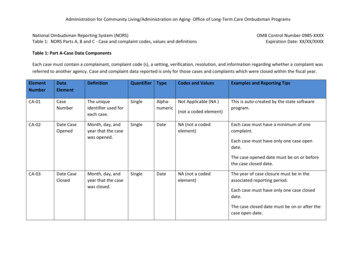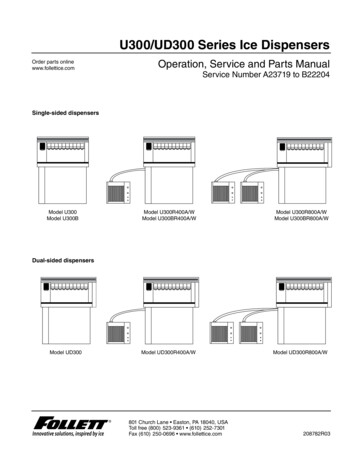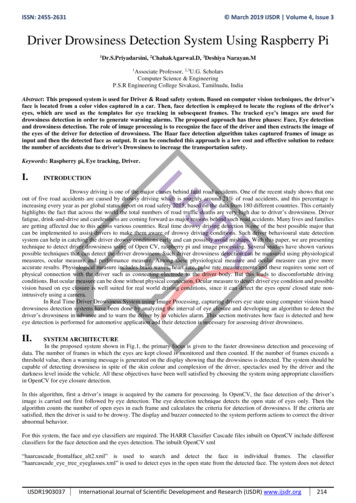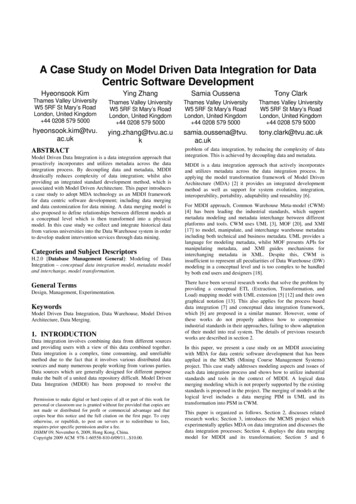
Transcription
A Case Study on Model Driven Data Integration for DataCentric Software DevelopmentHyeonsook KimYing ZhangSamia OussenaTony ClarkThames Valley UniversityW5 5RF St Mary’s RoadLondon, United Kingdom 44 0208 579 5000Thames Valley UniversityW5 5RF St Mary’s RoadLondon, United Kingdom 44 0208 579 5000Thames Valley UniversityW5 5RF St Mary’s RoadLondon, United Kingdom 44 0208 579 5000Thames Valley UniversityW5 5RF St Mary’s RoadLondon, United Kingdom 44 0208 579 del Driven Data Integration is a data integration approach thatproactively incorporates and utilizes metadata across the dataintegration process. By decoupling data and metadata, MDDIdrastically reduces complexity of data integration; whilst alsoproviding an integrated standard development method, which isassociated with Model Driven Architecture. This paper introducesa case study to adopt MDA technology as an MDDI frameworkfor data centric software development; including data mergingand data customization for data mining. A data merging model isalso proposed to define relationships between different models ata conceptual level which is then transformed into a physicalmodel. In this case study we collect and integrate historical datafrom various universities into the Data Warehouse system in orderto develop student intervention services through data mining.Categories and Subject DescriptorsH.2.0 [Database Management General]: Modeling of DataIntegration – conceptual data integration model, metadata modeland interchange, model transformation.General TermsDesign, Management, Experimentation.KeywordsModel Driven Data Integration, Data Warehouse, Model DrivenArchitecture, Data Merging.1. INTRODUCTIONData integration involves combining data from different sourcesand providing users with a view of this data combined together.Data integration is a complex, time consuming, and unreliablemethod due to the fact that it involves various distributed datasources and many numerous people working from various parties.Data sources which are generally designed for different purposemake the built of a united data repository difficult. Model DrivenData Integration (MDDI) has been proposed to resolve thePermission to make digital or hard copies of all or part of this work forpersonal or classroom use is granted without fee provided that copies arenot made or distributed for profit or commercial advantage and thatcopies bear this notice and the full citation on the first page. To copyotherwise, or republish, to post on servers or to redistribute to lists,requires prior specific permission and/or a fee.DSMM’09, November 6, 2009, Hong Kong, China.Copyright 2009 ACM 978-1-60558-810-0/09/11. 10.00.problem of data integration, by reducing the complexity of dataintegration. This is achieved by decoupling data and metadata.MDDI is a data integration approach that actively incorporatesand utilizes metadata across the data integration process. Inapplying the model transformation framework of Model DrivenArchitecture (MDA) [2] it provides an integrated developmentmethod as well as support for system evolution, integration,interoperability, portability, adaptability and reusability [6].For MDDI approach, Common Warehouse Meta-model (CWM)[4] has been leading the industrial standards, which supportmetadata modeling and metadata interchange between differentplatforms and tools. CWM uses UML [3], MOF [20], and XMI[17] to model, manipulate, and interchange warehouse metadataincluding both technical and business metadata. UML provides alanguage for modeling metadata, whilst MOF presents APIs formanipulating metadata, and XMI guides mechanisms forinterchanging metadata in XML. Despite this, CWM isinsufficient to represent all peculiarities of Data Warehouse (DW)modeling in a conceptual level and is too complex to be handledby both end users and designers [18].There have been several research works that solve the problem byproviding a conceptual ETL (Extraction, Transformation, andLoad) mapping model with UML extension [5] [12] and their owngraphical notation [13]. This also applies for the process baseddata integration [7] and conceptual data integration framework,which [6] are proposed in a similar manner. However, some ofthese works do not properly address how to compromiseindustrial standards in their approaches, failing to show adaptationof their model into real system. The details of previous researchworks are described in section 2.In this paper, we present a case study on an MDDI associatingwith MDA for data centric software development that has beenapplied in the MCMS (Mining Course Management Systems)project. This case study addresses modeling aspects and issues ofeach data integration process and shows how to utilize industrialstandards and tools in the context of MDDI. A logical datamerging modeling which is not properly supported by the existingstandards is proposed in the project. The merging of models at thelogical level includes a data merging PIM in UML and itstransformation into PSM in CWM.This paper is organized as follows. Section 2, discusses relatedresearch works; Section 3, introduces the MCMS project whichexperimentally applies MDA on data integration and discusses thedata integration processes; Section 4, displays the data mergingmodel for MDDI and its transformation; Section 5 and 6
summarizes . Related WorksSeveral researches have been suggested in order to overcome thechallenges in the design of data integration, when in context ofMDDI. In this section, we present a brief discussion about somerelevant approaches.In [6], MD2A (Multi Dimensional Model Driven Architecture) issuggested as an approach for applying the MDA framework toone of the stages of the DW development: multidimensional(MD) modeling. The authors defined MD PIM, MD PSM andnecessary transformations. Although the suggested frameworkand models covers formalized MDDI, the designed models do notproperly address data merging.For conceptual modeling of data mapping, [13] suggests an ETLmapping model with their own graphic notation. However, [12]conversely extends UML to model inter-attribute mapping at theattribute level. A conceptual model can be identified with a PIMin the context of MDA as it describes the necessary aspects of theapplication independently of the platform on which it will beimplemented and executed [2]. Although both works present themapping between a data source and target in different levels ofgranularity, they do not cover linking to PSM, which is usuallytransformed from PIM.[7] Proposes the model-driven generation and optimization ofintegration tasks using a process-based approach. The approachmodels data integration process in a high abstraction level inorder to raise portability and lower maintenance effort. Althoughit provides modeling whole integration process rapidly, it does notconsider details of each integration process modeling such as datamapping.student intervention. A brief explanation about each data sourceand their usage for MCMS is stated below:(1)Student Record System holds information about student recordsfor example student background, examination results and courseenrollment. It is the most important data source for our project.(2)Online Learning System allows tracing students’ activities invirtual class, which includes downloading of class materials andjoining online group discussion.(3)Library System provides information student loan history withdetails book borrowed.(4)Reading list system is hosted on the library system server, buthas separated database. It can help us track how often the studentsborrow books from the recommendation list.(5)Online Resource System holds logs of students’ access toonline resources such as e-book and online journal.(6)Programme Specification is a document which provides courseinformation. Text Ming was applied to find out course title,learning and teaching method etc.(7)Module Study Guide is a text data source which providesmodule information. It contains details of a module includingstudent assessment strategy, learning outcome and reading list.(8)Course Marketing System is developed for the purpose ofmarketing usage, which gives more course information.(9)Online Test System enables all to take online entrance skillscheck. It includes language, math and ICT ability test.Furthermore, several automated data merging approaches are alsoresearched in order to reduce human intervention for data mergingthrough extraction of combined meta data from source data orsource meta data in [14] and [15]. Particularly, [10] and [11]describes semi-automated model transformation using matchingtransformations and weaving models which can be applied to thegeneration of merged models.3. Mining Course Management Systems(MCMS) ProjectMCMS project [9] funded by JISC (Joint Information SystemsCommittee) proposes to build a knowledge management systembased on data mining in Thames Valley University. Different datasources from current university systems (such as the librarysystem, student administration, or e-learning) are integrated asData Warehouse (DW) [1] through ETL processes. Text mininghas applied to data extraction since a number of data sources arecombined together in different formats, including documents aswell as database files.3.1 Data SourcesIn this project, we have collected 3 years institutional historicaldata to build a DW and to predict individual student performanceand dropout as well as the suitability of the course or module forFigure 1. MCMS system overall architecture.Figure 1 shows the system architecture of MCMS: all data sourcesare integrated and transformed into data warehouse.Currently we have three years worth of data to work with: ForCourse marketing system, we have 5,458 records, which include1,881 courses; 5,352 Course Offering; 7 Schools and 7 Faculties.For Student Record system, there are 5,800 Students, 5,352Course Enrolments. For Library system, there are 144,604Borrowers, 3,150,816 Loans, 630,190 Items, 435,113 Works and45,900 Classification. For Reading-List system, there are 552Course, 1,540 List and 7,084 List Entry. For online Learningsystems, there are 2,460 module offering, and 2,021,334 onlineactivities.
3.2 Data Integration ProcessThe MCMS project has adopted MDDI associating with MDAapproach to build a DW. Every data model for each DW buildingphase has been designed as Platform Independent Models (PIM)first, and then automatically or manually transformed intoindividual Platform Specific Models (PSM) that are thentransformed into real codes for actual execution. This case studymainly concerns data merging and customization rather thanMulti-Dimensional (MD) design since the DW is not referencedfrom OLAP application but from data mining application in thisproject.Oracle 11g enterprise data base and oracle DW developer havebeen utilized as data base server and ETL tool respectively, andIBM rational architect and data architect for data modeling hasbeen used to activate the MDDI.As Figure 2 shows, data integration processes can be divided intofour phases; (1) analyzing and understanding data in the differentdata sources, (2) preparing and collecting data into staging area;usually one physical platform, (3) combining data through datacleansing, merging and, transformation, which is usually calledETL. Then finally, (4) customizing data according to applicationpurpose [19].because these tools tended to be tightly bound to physical models.As a result a new merging model has been developed in order todescribe the merged model using UML and rule description. Forexample, a student-mapping model describes the integration ofstudent information that are stored in of the student record system,library system, online learning system and, online test system.The details of this merging model are provided in section 4.(4) Phase of customizing data: As a final step, the datacustomization model was designed according to an applicationscenario. The modeling implied data aggregation anddenormalization for data query performance and efficiency of thedata mining application.3.3 TransformationIt is well known that logical models (PIM) provide not onlyguidance on how to integrate actual data but also automatedgeneration of real code which is ready for execution according toMDA viewpoints. In this context, PIMs, transformation for PSMsand, transformation for real code are necessary for each modelingphase.Most data source PIMs were derived from real data sourcethrough automated reverse transformation, with the support ofRational Data Architect (RDA) in this project. Analyzing the datasource PIMs, we designed Extraction PIMs with UML that weretransformed to PSMs with ERD and SQL codes in turn later. Thetransformations were also supported by RDA. Data merging PIMswere designed after building data cleansing strategy and thenmanually transformed into merging PSMs in Oracle WarehouseBuilder (OWB) [16]. PL/SQL packages were generated frommerging PSMs by OWB. The PIMs, PSMs, real codes and theirtransformations are shown briefly in Figure 3.Figure 2. Four modeling phases for the MDDI.(1)Phase of analyzing and understanding data: In this phase, it iscrucial to gather business requirements, determine data qualityrequirements and, understand data and its associated quality bothin the source system and across multiple source systems. Mostdata models were generated from each data source systemsdirectly using reverse engineering. However some data sourcemodels could not be derived directly from the data instances dueto different formats of data sources and security policy that led toinvolvement of domain experts or data specialist.(2)Phase of collecting and extracting data: Defining the gapbetween available data and its quality on business requirementswere followed as the next step. To remove the gap, the dataextraction models for each data sources were defined using theUML class diagram. For example, in student record system, aUML model is designed with the entities of the student, module,course, faculty, staff etc and, theirs relationship. Based on theextraction model, data preparation that includes: gathering,reformatting, consolidating, transforming, cleansing, and storingdata was processed both in staging areas and the DW.(3)Phase of merging and cleansing data: We designed our datamerging models to combine each extraction data models into aunited model, considering data cleansing as well. Several ETLtools support these processes including data cleansing and datamapping. However, the tools were not helpful in this design stageFigure 3. Models and transformations for MDA based MDDINowadays most data modeling tools support reverse engineeringwhich automatically transforms physical data schema into itsphysical ERD model and its logical UML model, as well asforward engineering for automated transformation of PIM to PSMand to real code as RDA and OWB does. Most ETL tools provideautomated generation of source code for metadata generation anddata processing by designing PSM based on CWM.Transformation between UML and CWM is the only form notsupported by ETL tools, as the tools do not provide conceptualdata modeling. UML as itself has shortages in expressing datamapping that requires defining relationships between attributes[13]. Therefore we proposed a conceptual data merging model
and rules to support transformation of merging PIM into mergingPSM. It will alleviate the issues a database designer has to keepconsistent data model by deriving the physical model and sourcecode from PIM during implementation. Details of the new datamerging model are shown in the next section.data objects for faculty. This ensures that when you merge thetwo elements together it changes the reference as well as data.4. Data Merging4.1 Data Merging Model (PIM)Our data merging model defines relationships between modelelements from different models at the conceptual level. Thisrelationship of meta data realize data mapping and shows how tomove each source data to the target.Our data merging model uses UML to express merging type andrelationship of merging entities. This is illustrated in Figure 4.Figure 5. An example of data merging PIM.The ruleCreateElment MG Faculty describes how to map theattributes of source elements, UE Faculty and CM Faculty, tothe target element, MG Faculty. The rule has a set of {sources,targets} and targets has a set of {target element name, a set ofattributes mapping}. Attribute mapping is expressed with arrowdirecting from source attribute to target attribute. As an example,DMUnion moves the first source element into a target element on‘insert’ basis and the others on ‘update and insert’ basis.4.2 Model Transformation (into PSM)Figure 4. The merging meta model.The root element, DMModel, is composed of DMType,DMElement and, DMLink elements. The description of eachelement is as follows: DMType is a base model of DMJoin, DMUnion andDMAssociation , which determines the merging method.A data mapping rule script attached on the DMTypespecified details of data mapping and their order. DMJoin is a type of merging which finds a joint data setof all linked source elements and moves the data into atarget element. DMUnion moves all data from each source elements toa target element according to their order. DMAssociate replaces association of source elements tothe one of the target. DMElement represents model elements including bothsource and target. DMLink shows relationship and directions of datamapping. DMSource inherits DMLink to identify source elements. DMTarget inherits DMLink to identify a target element.Figure 5 depicts a simple example of data merging model usingthe merging meta model. In this example, two model elementsfrom different systems have exactly the same data structure,however they differentiate through the reference of the differentThe PIM merging model can be changed into OWB PSM modelby model transformation rule. A DMElements is mapped into atable, especially DMSource references’ existing data table and aDMTarget creates new data schema to merge DMSource data.The full description of transformation rule is listed in Table 1.Table 1. Models Transformation RuleDM tion Rule-If DMElement is connected with DMSourcelink, generate a reference to an existing table.- If DMElement is connected with DMTargetlink: create new table schema including primarykey and foreign key constraints.-If an attribute of DMElement is not a primitivetype, change table constraints on foreign key toreference a proper element.-Create data mappings as much as the numberof DMSource links.-According to the mapping order in rule script,each data mapping from a source to a target istransformed into each attribute connectionbetween source and target elements in turn.- If attributes of source and target are not sametype, insert data type change function beforemapping data.-Create a data mapping using joiner entity tomerge source elements-From rule script, joining condition andmapping sequence are determined.-Change target table schema-Update target table schema to reference asource table with foreign key constraint.
DMLSource/DMTarget- No correspondent transformation. Just indicatewhether a linked DMElement is a sourceelement or a target one.As an example, the transformed PSM of Figure 5 is shown inFigure 6. Since the DMUnion is transformed into several OWBdata mappings depending on number of source elements, two datamappings are created in this example. According to theruleCreateElment MG Faculty, UE FACULTY element ismappedintoMG FACULTYthenCM FACULTY.CM FACULTY.FACULTY NAME is converted to string data typebefore it is mapped since the target MG FACULTY.NAME is ofdifferent data type.[2] Kleppe, A.,Warmer, J. and Bast,W. 2003. MDA Explained.The Model Driven Architecture: Practice and Promise.Addison-Wesley, Reading.[3] Object Management Group (OMG). 2009. Unified ModelingLanguage (UML), Specification 2.2[4] Object Management Group (OMG). 2003. CommonWarehouse Metamodel (CWM), Specification 1.1[5] Vassiliadis, P., Simitsis, A., and Skiadopoulos, S.Conceptual Modeling for ETL Processes, OLAP’02. 2002.[6] Mazon, J., Trujillo, J., Serrano, M., and Piattini, M.Applying MDA to the development of Data Warehouses,DOLAP’05, 2005.[7] Bohm, M., Habich, D., Lehner, W., and Wloka, U. Modeldriven development of complex and data intensiveintegration processes, MBSDI 2008, CCIS 8, pp.31-42[8] Chaudhuri, S. and Dayal, U. 1997. An overview of datawarehousing and OLAP technology. SIGMOD Rec. 26, 1(Mar. 1997), 65-74.Figure 6. An example of data merging PSM.The following script shows a part of generated PL/SQL packagecode from the PSM of Figure 6. . IF NOT "MG FACULTY St" THENbatch action : 'BATCH INSERT';batch selected : SQL%ROWCOUNT;INSERTINTO"MG FACULTY" ("FACULTYID", "NAME")(SELECT "UE FACULTY"."FACULTYID" "FACULTYID","UE FACULTY"."NAME" "NAME"FROM "UE FACULTY" "UE FACULTY" 5. CONCLUSIONIn this paper, we have presented a case study that shows detailedprocess of an MDDI with specific models for each individualmodeling phases. In this case study, our aims were to maximizethe utilization of current industrial standards for an MDDI projectand to propose a logical data-merging model that the standardshave not referenced. We demonstrated the possibility of our datamerging model and how efficiently and rapidly a DW can bedeveloped in the MDDI approach through the MCMS project inThames Valley University. We modeled each data source withUML to extract designated data from different data sourcesystems. We then designed merging models to integrate all datainto one united model as well as customizing the data models fordata mining.[9] Oussena, S. 2008. Mining Courses Management Systems.Thames Valley University. http://samsa.tvu.ac.uk/mcms[10] Fabro, D.D.M. and Valduriez, P. Towards the efficientdevelopment of model transformations using model weavingand matching transformations, Conference of Software andSystems Modeling 2008.[11] Marcos, D.D.F., Jean B. and Patrick V., Weaving Modelswith the Eclipse AMW plugin, Eclipse ModelingSymposium 2006.[12] Mora1, L.S., Vassiliadis, P., and Trujillo, J., Data MappingDiagrams for Data Warehouse Design with UML, volume3288 of Lecture Notes in Computer Science, pp 191-204.[13] Vassiliadis, P., Simitsis, A,. and Skiadopoulos, S.Conceptual Modeling for ETL Process, ACM FifthInternational Workshop on Data Warehousing and OLAP2002.[14] Konigs, A. Model Transformation with Triple GraphGrammars. Model Transformations in Practice SatelliteWorkshop of MODELS 2005. Montego Bay, Jamaica.[15] Embley, D.W., Xu, L., and Ding, Y. Automatic Direct andIndirect Schema Mapping: Experiences and LessonsLearned, SIGMOD Record, Vol. 33, No. 4, December 2004.[16] Oracle Warehouse Builder (OWB) 11g ducts/warehouse[17] Object Management Group (OMG). 2007. XML MetadataInterchange (XMI), Specification 2.1.We believe these models and the transformations can be reused asa DW modeling framework for any universities that need to builda united data repository for enhanced data utilization anddecision-making. Currently we are formalizing our datatransformation using MOF QVT (Query/View/Transformation)for automated PSM generation. Automated data merging andcleansing using data mining is also considered as future works.[18] Medina, E. and Trujillo, J. A Standard for RepresentingMultidimensional Properties: The Common WarehouseMetamodel (CWM). Lecture Notes In Computer Science,vol. 2435. Springer-Verlag, London, 232-247.6. REFERENCES[20] Object Management Group (OMG). 2005. Meta ObjectFaciality (MOF) Specification 2.[1] Kimball, R. and Ross, M. 2002. The Data WarehouseToolkit, second edition, John Wiley & Sons.[19] Rahm, E., and Do, H. H. 2000. Data Cleaning: Problems andCurrent Approaches, Journal of IEEE Data EngineeringBulletin, volume 23.
models data integration process in a high abstraction level in order to raise portability and lower maintenance effort. Although it provides modeling whole integration process rapidly, it does not consider details of each integration process modeling such as data mapping. Furthermore, several automated data merging approaches are also






